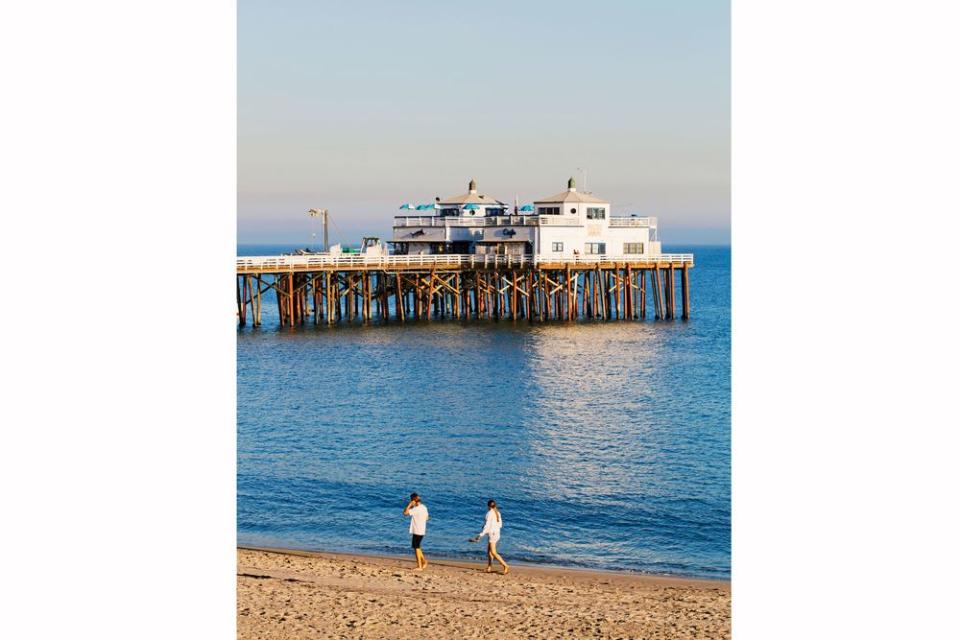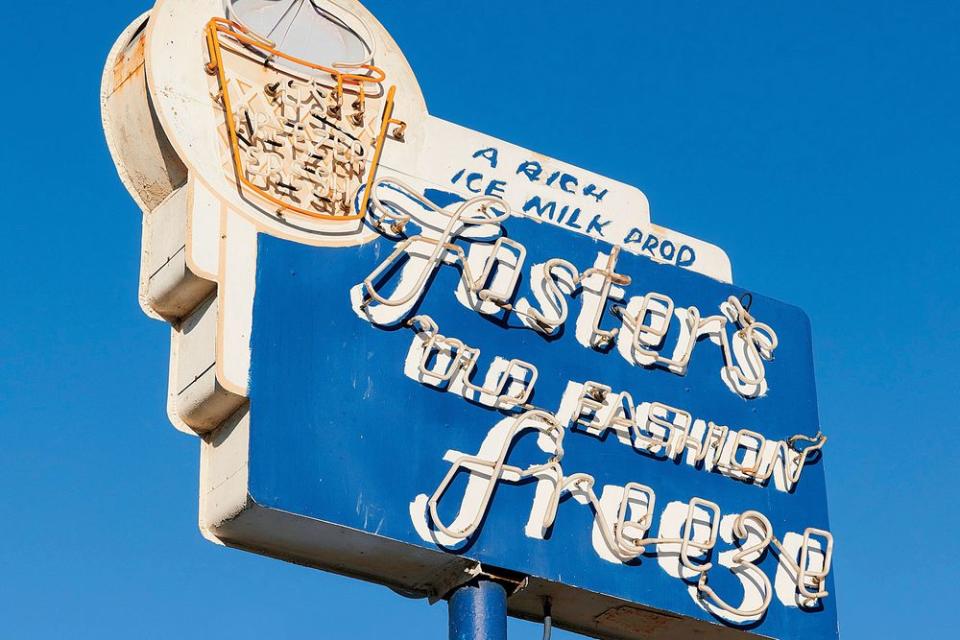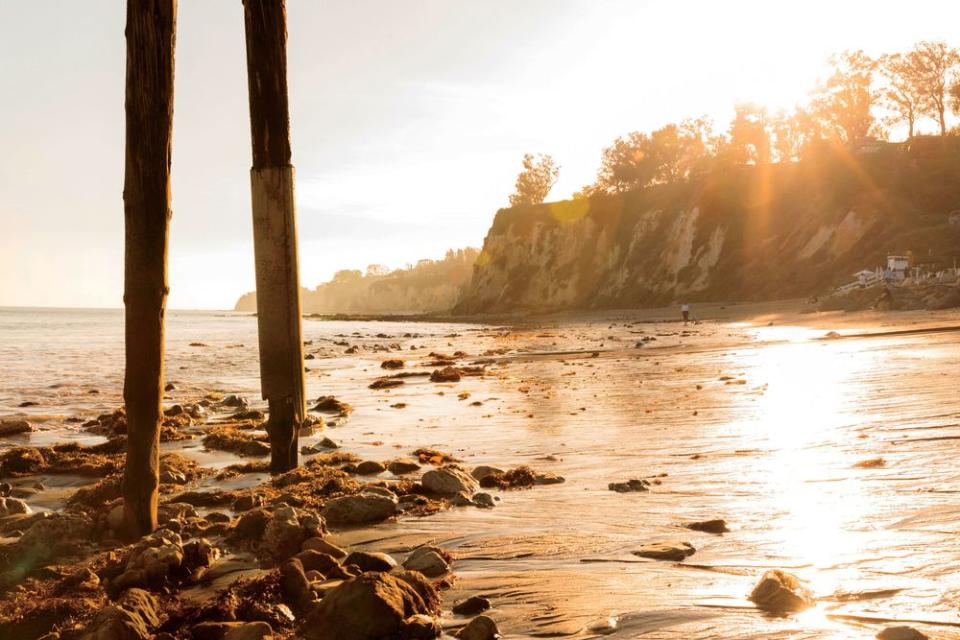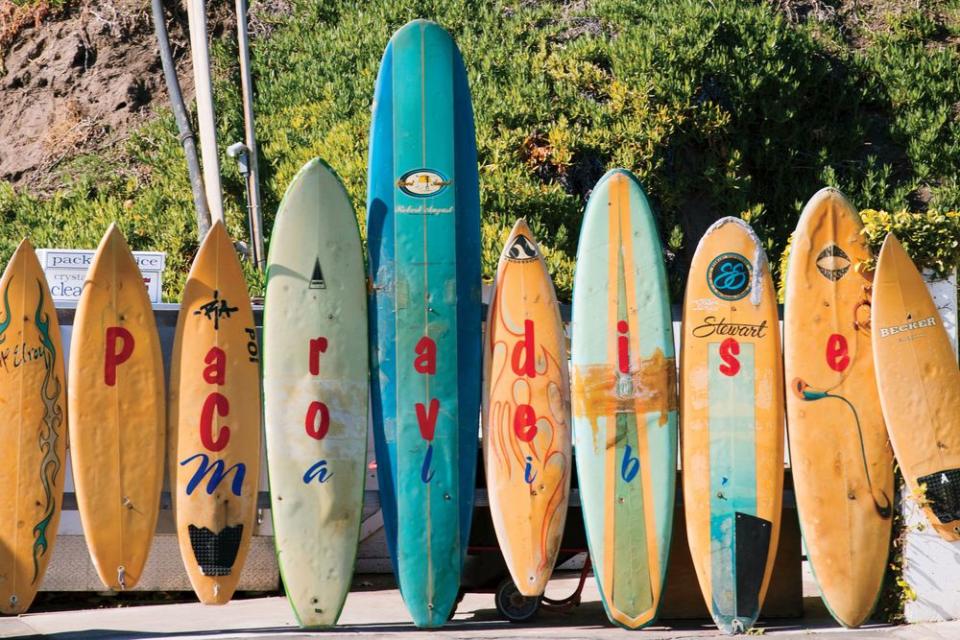The Beach Boys-Inspired Road Trip You Have To Take This Summer
As the westbound I-10 dead-ends at the Pacific Coast Highway, I ask Siri to play "Surfin' Safari." So what if I'm in a rented Hyundai? So what if it's stop and go for miles? This is Beach Boys country, and I'm headed for Malibu.
Few places in the world come with as mandatory a soundtrack as this stretch of coast, especially for someone like me: Boston kid. Gidget fixation. The Endless Summer movie poster on bedroom wall, and student (briefly) of the snare drum—because, well, the "Wipe Out" solo.
Related: The Ultimate Guide to the Beaches of The Beach Boys
I wasn't alone. The Beach Boys and other 1960s bands spawned a nationwide obsession with their native Southern California and its youthful surf culture. In their music, we heard freedom and fun and the kind of love you fell in when you were barefoot and the sun was melting into the Pacific. That's why I'm here: I've come to search the coast for the roots of those good vibrations that still fill me with jubilation.

Malibu—playground of the real Gidget and backdrop for iconic Beach Boys album covers—is just the place to begin. I check in to The Surfrider Malibu, a fashionably updated 1950s motel across from its namesake Surfrider Beach. From my balcony, I spot dozens of surfers in the waves breaking 100 yards offshore. This, I realize with outsize glee, is roughly what 15-year-old Kathy Kohner (now Zuckerman) would have seen in 1956 when she dragged a longboard across the sand and dared to join the local guys, who nicknamed her "Gidget." In 1957, Zuckerman's screenwriter father drew on her experiences to write a best-selling novel. Two years later, the film adaptation was a commercial success, shining an even brighter light on surfing and the fun-in-the-sun scene that surrounded it.

The sport swelled in popularity as a result, and the crowds brought something new to the beach: transistor radios, which made the Top 40 portable. And coming from those tiny speakers were two new forms of homegrown surf music. One was a twangy, reverb-heavy instrumental rock developed by Orange County guitarist Dick Dale. The other was that sunny vocal pop exemplified by L.A. County's Beach Boys: brothers Brian, Dennis, and Carl Wilson; their cousin Mike Love; and friend Al Jardine.
The group's buoyant, closely stacked harmonies painted vivid pictures of the teen-dream beach life (despite the fact that only Dennis surfed and Brian later confessed to being scared of the ocean). In 1961, at Dennis's suggestion, the fledgling group recorded "Surfin'," which went to No. 2 on the L.A. charts. From there the group took off, signing with Capitol Records and putting up a string of hits, including "Surfin' U.S.A.," "Surfin' Safari," and "Surfer Girl." By 1963, The Beach Boys were Billboard's top singles act. They were sitting on top of the world.

Being a beach music pilgrim is a two-track pursuit: Check out the spots your heroes hail from, and pay homage to the beaches named in their songs. The latter choice is irresistible, so I head north to the Ventura County line immortalized in "Surfin' U.S.A." The landscape is surprisingly low-key: an asphalt ribbon of Pacific Coast Highway, often dusted with sand, separating beaches from the occasional businesses that survive on the needs of surfers and beachgoers. In this case, on one side is County Line Beach, and on the other, Neptune's Net, a circa-1958 seafood shack and longtime hangout for bikers out for PCH joyrides. On the deck, I tuck into a very good bowl of clam chowder and watch surfers pull up in their bumper-sticker-plastered trucks, hoist their boards overhead, and pick their way over the bluff's edge to the sand below.
Breaking free from the seductive gravity of that endless-summer spot, I head inland for a sentimental tour of Beach Boys landmarks. In Hollywood, I visit the group's Walk of Fame star, in the sidewalk near the famously cylindrical Capitol Records building. And in Silver Lake, I find a trove of Beach Boys vinyl and memorabilia at Rockaway Records. In a glass case, I spot a 1973 concert poster for $250 and unpublished 1966 photos for $400. Just a week earlier, Rockaway sold a surfboard owned by Dennis Wilson for $75,000.

Driving south through the Wilsons' hometown of Hawthorne, I roll past their alma mater, Hawthorne High (Be true to your school), where the band returned in 1969 to play for the prom. There's also a blue-roofed Fosters Freeze, said to have inspired the lyrics in "Fun, Fun, Fun" (Well she got her daddy's car and she cruised through the hamburger stand now). While the Wilson family home on West 119th Street is no longer there, a California Historical Landmark plaque pinpoints the location. Out of more than 1,000 such official markers, it's the only one dedicated to a rock-and-roll site.
Putting Hawthorne in the rearview mirror, I ask Siri for more beach music and head west to Manhattan Beach, shouted out in "Surfin' U.S.A." Unlike the quiet scene near Ventura County, a denser, more fun-loving urbanization of surf life hums here along two miles of broad, pale sands. I cruise the PCH south, digging the similarly buzzy vibe in Redondo Beach, also touted in "Surfin' U.S.A." My goal, though, is that spot where they're forever shooting the pier, as the song goes: Huntington Beach.
And indeed, I arrive to spy those swells that crash through and carry surfers past the tall legs of that iconic pier. Stretching in both directions is a vista worthy of its own album cover: patchworks of beach towels, lifeguards keeping watch from their towers, volleyball games, skimming Frisbees, and hovering, squawking gulls. In the palm-shaded downtown, I browse board shops, stroll the Surfing Walk of Fame, and check out the International Surfing Museum. "Surf City," the 1963 hit record by Jan & Dean that inspired Huntington Beach's official nickname (and on which Brian Wilson sings), seems to be playing everywhere I go.

While Huntington Beach is a dreamy discovery, I save the best for my final day in California. Back in Malibu, I make for Paradise Cove, the beach immortalized on the Surfin' Safari and Surfer Girl album covers.
As I walk the sand toward that bluff I've stared at on my copy of Surfin' Safari, I'm struck by the moment frozen in that 1962 photo. How could the boys have known, as they peered out to sea, that the British Invasion, protest songs, and psychedelic rock lurked just over their shoulders? On the other hand, could they have predicted that Dean Torrence, Dick Dale, The Surfaris, and The Beach Boys—Brian, Mike, Al, and friends—would still be touring in 2018?

Kathy Zuckerman probably never had any doubt. When Surfer magazine named the 25 most influential surfers in history, Gidget made the list at No. 7. And you can find her today telling stories at Duke's Malibu restaurant, where, at the age of 77, she still works part-time.
"They call me Gidget at work," she says, although she stopped surfing years ago. "People want to meet me and talk about surfing and have their pictures taken with me," she adds. "It's uplifting that people are still intrigued."
I think about that eternal sunshine of a plucky girl on a surfboard and the movement she and The Beach Boys helped spawn. I think about the Malibu of Zuckerman's youth."It wasn't about what was happening on the beach, or the clothes you wore," she says, thinking back. "It was about looking at the horizon and seeing a swell coming."

On the sands of Paradise Cove, I check that horizon and see surfers bobbing in the swells. The scene feels as timeless as those songs I love, even though these tan, wild-haired kids weren't even born when the Wilsons invited us to come on a safari with them. But here we all are, soaking up the hazy SoCal sun and finding our hearts catching the rhythm of waves crashing to shore.
WATCH: A 15-Second Escape to Malibu, California
Get Here
Malibu is about a one-hour drive from Los Angeles International Airport.
Stay Here
Ventura-born architect and surfer Matthew Goodwin, his wife, Emma, and business partner Alessandro Zampedri have created an airy beach-house feel at The Surfrider Malibu, their smart overhaul of this landmark roadside 1953 motel. Designed in sandy neutrals—linen, jute, and reclaimed teak—the 20 serene rooms and guests-only roof deck overlook Malibu Pier and Surfrider Beach. Rates start at $350.
In Huntington Beach, the waterfront Kimpton Shorebreak Hotel works the surf-shack vibe and is steps from both Main Street and the beach. Rates start at $199 (mandatory $30 resort fee includes beach chairs, bikes, fireside s'mores, and the services of the hotel "surf ambassador").
Surf Here
In Malibu, do like the movie stars do and learn from John Philbin, who's coached neophytes for popular films like North Shore and Point Break—and often appears in them himself. Book private or group lessons at every level.
At the center of Manhattan Beach's action, Camp Surf offers private and group lessons, camps, and surf parties.
The surf ambassador at Kimpton Shorebreak Hotel will book Huntington Beach–based surf lessons for guests.
Based at a deluxe campsite in San Onofre State Beach, Endless Summer Surf Camp runs daylong and weeklong surf-camp sessions, plus private, semiprivate, and group lessons.


